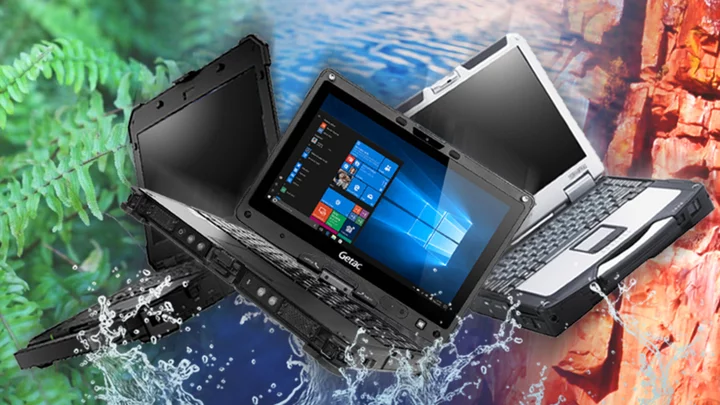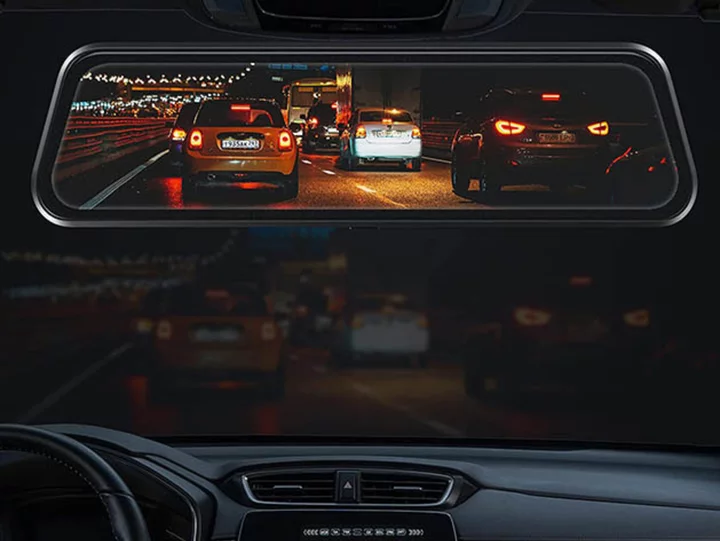Who's tougher, Dwayne Johnson or Jason Statham? The answer (obviously, Chuck Norris) is about as inconclusive as advertisements for laptops with vague, overlapping descriptions like "semi-rugged," "fully rugged," and "business-rugged." But the need for notebooks that can take a licking and keep on clicking is very real.
Let's be clear right up front about one thing: When PCMag refers to "rugged laptops," we're not talking to travelers with business laptops, worried about a little turbulence knock-about in an airline overhead compartment. Really rugged laptops are vertical-market dwellers, designed for work in the field or on factory floors. They may be carried by first responders or military personnel, or get mounted on police-car dashboards. They may have to survive being rained on or dropped six feet onto a hard surface, or work through freezing or broiling temperatures, or keep from getting clogged up by clouds of blowing dust or sand.
What's the price you pay for such super-sturdy survivability? One is, indeed, the literal price: Rugged laptops cost a lot more than their civilian counterparts. Two, the weight: A laptop with virtual armor plating can test your biceps to the tune of 10 pounds, an immense burden compared to the three or four pounds of most laptops. That's why many of the true-blue rugged models come with pop-out carrying handles.
Time to look at some tougher-than-average laptops and convertibles! The models below are some of our favorites PC Labs has tested. Let's look at the pros and cons of each one, before getting into a few more details you need to know before you buy a rugged laptop, concluding with a spec breakout of all the models we've tested.
For users who need serious computing power in hostile environments, there's no substitute for a laptop that can laugh off mistreatment that would destroy an ordinary machine. Let's run through the key things to look for as you shop. Fasten your seat belts, it's going to be a bumpy ride.
Right to Business: What Is MIL-STD 810G?
Before we get into brawny machines that can survive six-foot drops and jets of water, we must acknowledge that not all mainstream notebooks are frail and fragile. Some Lenovo ThinkPads, HP EliteBooks, and other business systems are reasonably resistant to bumps and bruises, though they can't survive high dives or liquids in excess of minor keyboard spills. Even some Chromebooks carry the same designation as these hardy travelers—MIL-STD 810G, which indicates compliance with a series of tests required for the US Department of Defense to consider using a piece of equipment in a military setting.
The MIL-STD 810G standard spans over 800 pages and nearly 30 laboratory test methods for challenges ranging from weather (high and low temperatures, rain, and humidity) to physical forces (acceleration, vibration, and shock). Few computer vendors push their products over every hurdle that the standard posits, including such tortures as a gunfire-recoil shock, icing or freezing rain, whether a laptop might spark an explosion in flammable-gas atmospheres, and—wait for it—resistance to fungus. Rather, the manufacturer may note that the system has passed, say, 10 or 12 MIL-STD tests.
The trouble with a MIL-STD 810G sticker on a laptop's box or a vendor's website is that it doesn't tell you enough. Because no independent agency certifies MIL-STD compliance, it's up to you to look for documentation or details of which tests a product passed, who conducted the tests—the manufacturer, or an outside lab—and how the tests were performed. For example, since users are prone to drop laptops, certification for shock is a popular claim. But there's no rule about what height to drop a device from.
Does this make the certification useless? Not at all. Just think of it as a checklist item or the first thing to look for, rather than a guarantee of bulletproof reliability, and be aware that you need to read the fine print.
Braving the Elements: What Do IP Ratings Mean?
A more stringent abbreviation seen on seriously sturdy laptops is a code such as "IP65." The IP stands for "ingress protection"—the ability to keep solids or liquids out of the machine's vulnerable innards. This rating is measured numerically, rather than by general terms such as "dustproof" or "water-resistant."
You can read our primer on IP and MIL-STD ratings for full details, but here's IP in a nutshell. The first digit after the letters "IP" denotes safety against solids, on a scale of 0 to 6. The number 2 means you can't stick your fingers into the device. The number 4 means the system is proof against objects larger than 1mm, such as most wires; 5 means some, and 6 means complete protection against dust and sand.
The second digit after IP measures protection against liquids, this time on a scale of 0 to 9. A device rated 1 can resist a few vertical drips; 4 means splashing water and 5 means jets of water; and 7 and 8 refer to immersion in less than one meter, and in one to three meters, of water respectively. Unlike some smartphones, no laptop that we know of is safe to wholly submerge, so don't expect to see a liquid rating higher than 5.
A sure sign that a manufacturer is serious about an IP rating is sealed ports—doors that cover connectors such as USB ports and HDMI video outputs. Differences in these doors can contribute to differences in ratings: Those of the Acer Enduro Urban N3, for instance, snap securely shut as part of the system's IP53 chops...
The doors covering the Panasonic Toughbook 40's ports, by contrast, are waterproof, with sliding lockable latches, contributing to the laptop's IP66 rating.
What Are Rugged Laptop Chassis Made Of?
Other things to look for in a rugged laptop start at first sight—its outer case or chassis. Obviously, the thin plastic of many consumer models turns to shrapnel when faced with what rugged PCs go through, though it's amazing what a little reinforcement can do. For example, classroom-computer specialist CTL says the lid of its Chromebook NL61TX (supplanted since our review by the NL7X) can withstand the weight of a few books piled on it in a desk or backpack—can withstand, in fact, 365 pounds of pressure before the screen breaks.
More common chassis materials include magnesium or magnesium-aluminum alloys, with rubber or rubberized bumpers on a laptop's corners as a popular protective measure against drops. Models like the Dell Latitude 7424, for one, can even have a steel-reinforced security lock.
We've already discussed doors that cover ports, but as with any laptop, you should consider which ports you need. Machines built for duty on factory floors are among the last that still have RS-232 serial ports, often used for connection to legacy data-collection equipment. Others feature modular or swappable bays for storage drives or batteries, or slots for mobile-broadband SIM cards so you can go online when out in the field, away from Wi-Fi hotspots.
While you can't see them easily, many rugged laptops have specially shock-mounted components. It was a boon for the category when jolt-resistant solid-state drives (SSDs) replaced relatively delicate spinning hard drives, but some vendors go beyond that—the Panasonic Toughbook 31 actually has a heated SSD that keeps working in frigid temperatures.
Real Hands-On Issues: Factoring in Gloves and Rain
Virtually all laptop screens are good enough for work in your average office. Take one outside, however, and it's a whole different story.
Looking at a typical display panel in direct sunlight can render it invisible, without enough contrast to make out more than the palest ghost of an image. That's why many rugged laptops boast extra-bright displays, with 1,000 or more nits of brightness compared to the 200 to 400 of most indoors-optimized systems.
You'll also find reinforced glass to combat cracking or shattering, though you almost certainly won't find the 4K (3,840-by-2,160-pixel) resolution of conventional flagship laptops—rugged screens tend to peak at full HD or 1080p (1,920 by 1,080 pixels), with some settling for even lower, older resolutions such as 1,024 by 768.
On these laptops, note that touch screens are a special case. Most of today's touch-screen notebooks use capacitive technology, in which a near-transparent digitizing layer over the panel detects your finger via the electrical conductivity of your skin. Fine, but what if you're wearing gloves? Oops—capacitive tech doesn't work. The solution is a resistive touch-screen design, in which—with a slightly harder push from you—the top layer flexes to close a circuit with another layer beneath it.
The same goes for the touchpads located in laptops' palm rests. Capacitive pads are no good if you're wearing gloves or if it's raining, whereas a two-layer resistive touchpad can track in wet or adverse conditions. On the minus side, you may discover that a resistive pad requires so much pressure that it feels clumsy with a dry, bare finger.
Tablet-based designs take this even further with glove-friendly touchscreens, stylus input, and physical buttons, ideal for use in cold or wet weather where the user might be wearing gloves.
We mentioned that many business systems have spill-resistant keyboards and drainage holes in their bottoms to save your bacon if you spill a few ounces of water, so it's no surprise that rugged keyboards are designed not to drown with even greater amounts. Depending on the weather where you work, some manufacturers offer a choice of keyboards built for wet or wetter conditions, the latter with rubberized or coated keys that sacrifice a little typing feel to provide extra protection.
So, What Is the Best Rugged Laptop to Buy?
At a minimum, every rugged laptop has passed MIL-STD tests; at the maximum, they're the next best thing to bulletproof. We'll refresh this guide as we review additional true-rugged systems; meanwhile, check below for a spec breakout, in detail, of our suggested models above. Thanks for reading, and let's be careful out there.









